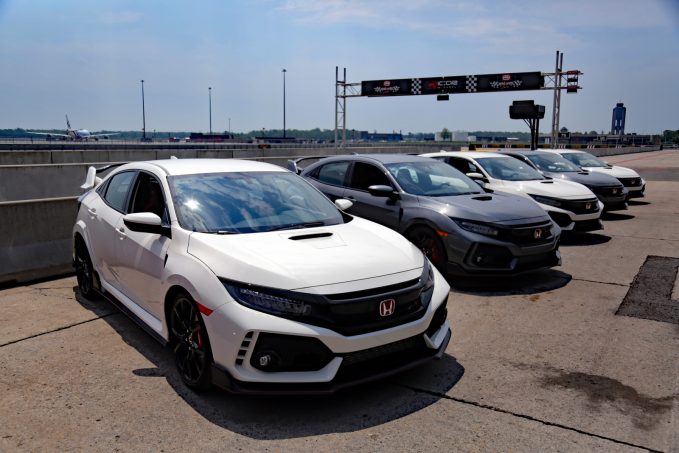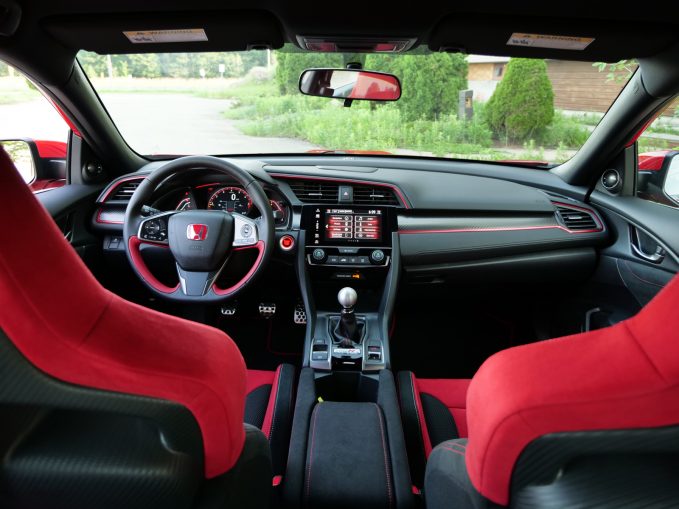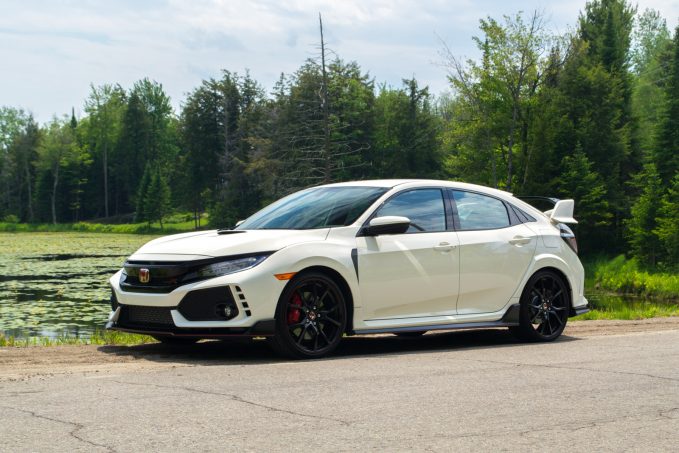The closer the 2017 Honda Civic Type R is pushed to its outer limits, the sooner it becomes clear that this car is something special.
Hustle into a corner at, say, seven-tenths or more and there’s nary a hint of understeer, the sworn enemy of front-wheel drive. It’s the same story when mashing the accelerator at the apex, with torque steer virtually non-existent, the car pulling hard as it climbs through the gears.
So this is what all the hype’s been about.
Considering it was never sold here, the Civic Type R has garnered quite the reputation in this part of the world. For 20 years the hopped-up Honda has been both renowned and revered in North America, its red badge tantalizing a passionate enclave of enthusiasts. That makes this a moment that Honda fanboys and fangirls here have been waiting for in earnest. Judgement Day is here.
The significance of this new Civic Type R certainly isn’t lost on Honda. Past improprieties aside, the brand knows this car has to be good. Like, really good. After all, it doesn’t just have a reputation to maintain, but it’s also facing some pretty stiff competition for sport compact supremacy. Alongside the Volkswagen Golf R and Ford Focus RS, it completes a holy trinity of hot hatches that were each but a dream just a few short years ago. Add in the Subaru WRX STI for good measure, and this Super Civic is staring down quite the gauntlet.
Get the Flash Player to see this player.
From Mundane to Insane
Just like those cars, the Type R’s formula is as simple as it is maniacal. Start with a commuter car, replace all the important bits with stuff that’ll make it go faster, and sell it at a reasonable price. But to begin to realize what this new Type R is all about, it’s important to forget most of what you know about the Honda Civic hatchback. Yes, the Civic Type R is built on the five-door’s foundation; and yes, it’s fundamentally the same in size and stature. But just about everything in it and on it has been swapped out in the name of performance.
ALSO SEE: 2017 Honda Civic Si Review
Starting under the hood, a 2.0-liter turbo motor handles power generation, and does a damn fine job of it. The engine makes a stout 306 horsepower and 295 lb-ft of torque, the latter of which comes online at 2,500 rpm and sticks around until 4,500 rpm. Paired to that powerplant is a Type R–exclusive six-speed manual gearbox, with a helical gear-style limited-slip differential in place to reduce wheel spin, and an active rev-matching system for those who struggle to heel and toe.
Both the engine and transmission are the same as what was in the last, Europe-only Civic Type R, though most of the internals in both have been beefed up this time around despite output remaining static. Elsewhere, the car gets entirely new underpinnings, including adaptive dampers at all four corners, bigger brakes, and thicker sway bars. Even the steering ratio has been changed compared to the standard Civic in an effort to improve the car’s responsiveness. Rounding out the changes is a drive mode selector that adjusts everything from steering and throttle response to the rev-matching system, adaptive dampers and stability management to amp up or tone down performance as required.
Take it to the Track
With Honda shipping a handful of journalists to Montreal to drive the Civic Type R for the first time, a trip north of the city to Circuit ICAR in Mirabel was in order. Built on the former runways of a mostly unused international airport, the 2.1-mile (3.4-kilometer) track is Sebring-esque in its execution. While not particularly challenging, the track is extremely flat and features tight turns and limited visibility, a victim of its flat topography.
It only took a few short laps for the Type R’s abilities to become abundantly clear. The car itself is so light and nimble and, perhaps more importantly, communicative, proving very easy to anticipate what the car is going to do next. With the drive mode selector set to +R, the most aggressive of the three on tap, the dampers stiffened nicely without losing any adaptability, while the already nicely weighted steering added just enough resistance to notice a change.
Much like Sebring, the track at ICAR is rather bumpy, a byproduct of its concrete slab surface. However, even the stiffest suspension setting wasn’t enough to risk upsetting the balance of the car as it was tossed headlong into washboard corners. The Type R still managed to hunker down nicely as the weight shifted front to back and side to side through esses and sweepers alike. With the Type R’s lightning quick steering ratio, executing even the tightest of turns successfully is almost effortless.
Unlike its chief competitors, this piece of formerly forbidden fruit sends output to the ground through the front wheels alone. Expecting understeer as a result is understandable, though surprisingly inaccurate. Not only is the Civic Type R free from half the drivetrain power loss of its rivals, but tackles turns just as well without skating to the outside.
ALSO SEE: 2017 Ford Focus RS vs Volkswagen Golf R
There’s also endless amounts of grip, the Type R feeling like it was on a slot car track the way it grabs on even the roughest pavement — of which there’s plenty in Quebec. On uneven asphalt the Type R simply skips and then grips, sorting things out with little reason to worry. Slowing the car is also done in a hurry courtesy of the upsized brakes at all four corners, with no noticeable fade after two days of driving.
Whether rolling on the throttle or mashing the accelerator on corner exit, expectations for torque steer went thankfully unfulfilled. While much of the credit goes to the limited-slip differential that’s sandwiched between the motor and gearbox, it also speaks to how smoothly the engine’s output is delivered. While throttle response is rapid it’s seldom overwhelming, and never encroaches on control. The engine feels like it could easily be revved to 11,000 rpm without skipping a beat. Okay, s
o it’s more like 8,000 rpm, but the rev limiter does at times seem to put a damper on the engine’s potential. Not that its redline is exactly low, with 7,000 revs to work with before the computer steps in. Oh, the joys of VTEC.
Working through the gears, the transmission feels mechanical and substantial, and rectifies any complaints I’ve had about about the featherlight setups Honda is known for. While there’s no need to manhandle the short-throw shifter between the seats, its pronounced gates simply begged to be rowed, while the clutch pedal offers just the right amount of resistance. Running back and forth through the gearset is still exceptionally smooth, but like the car itself, the process offers enough feel and feedback to add to an already visceral experience.
The more time you spend behind the wheel the more confidence it inspires. But not only is the Civic Type R user-friendly, it’s also incredibly precise. I was never fortunate enough to drive any of the previous iterations before this one, but I imagine they are strikingly similar in the delivery of exceptional levels of performance in a package that will feel familiar to anyone who has driven a current-generation Civic.
Take it to Work
Whether on the track or otherwise, you can count on the same stellar levels of performance from the Civic Type R. It happily carved up the country roads outside Mirabel, feeling as eager as any of its foes. But best of all, it offers a split personality that works well for more docile drives.
And it’s only during commuting duty that I can see the car’s extreme styling posing a problem for some. While everything from the hood scoop to the massive rear wing — and even the so-called “vortex generators” that flank the shark-fin antenna — is functional, the whole package is a little over the top for a daily driver.
ALSO SEE: 2018 Volkswagen GTI vs Golf R: Which Hot Hatch Should You Buy?
While the interior tells a similar story, it’s steeped far more heavily in history. The bolstered red seats have been part of the Type R equation since 1997, and add to the cabin’s form and function. It also sacrifices very little practicality compared to more run-of-the-mill Civic hatchback models, with only the center seating position in the second row absent. Otherwise it offers the same 25.7 cu-ft (728 liters) of cargo room behind the rear seats and 46.2 cu-ft (1,308 liters) with them folded. Better yet, the cabin passes the helmet test with flying colors, the ceiling easily able to accommodate one of Bell’s finest perched atop my 6-foot-4 frame.
The Verdict: 2017 Honda Civic Type R Review
It looks like the sixth time’s the charm for the Honda Civic Type R in North America, with the much ballyhooed sport compact finally making landfall here — and it was certainly worth the wait. It does more than just complete the hot hatch holy trinity, it could very well be the crown jewel.
Of course, some antagonists will insist that this new Civic Type R can’t compete with the likes of the Ford Focus RS and VW Golf R based on its front-wheel drive layout, and those people are what I like to refer to as “wrong”. It’s fully reasonable to expect the Type R to give any 300-horsepower sport compact a run for its money. And speaking of money, the as-tested price of $34,775 including destination undercuts all its competitors by quite a bit, making the Civic Type R a helluva buy, too. I’ll take mine in Championship White, please.











